Financial Analysis and Decision Making for Harvey Homes Plc Report
VerifiedAdded on 2019/12/28
|19
|4252
|145
Report
AI Summary
This report presents a comprehensive financial analysis of Harvey Homes Plc, a public sector firm in the real estate and construction industry. The analysis begins with an executive summary highlighting the company's good liquidity and solvency, while recommending strategic improvements in profitability. The report then delves into business performance, utilizing profitability ratios (gross profit, operating profit, and net profit), liquidity ratios (current and quick ratios), and the debt-equity ratio to assess the company's financial health. Furthermore, the report examines the cash flow statement and calculates the operating cash cycle to evaluate the efficiency of cash management. The report also explores investment appraisal methods and suitable financing sources, such as bank loans and equity financing, for potential acquisitions. The analysis reveals insights into the company's performance, identifies areas for improvement, and suggests strategies to enhance financial outcomes, making it a valuable resource for understanding the company's financial position and decision-making processes.

FINANCIAL DECISION
MAKING
MAKING
Paraphrase This Document
Need a fresh take? Get an instant paraphrase of this document with our AI Paraphraser
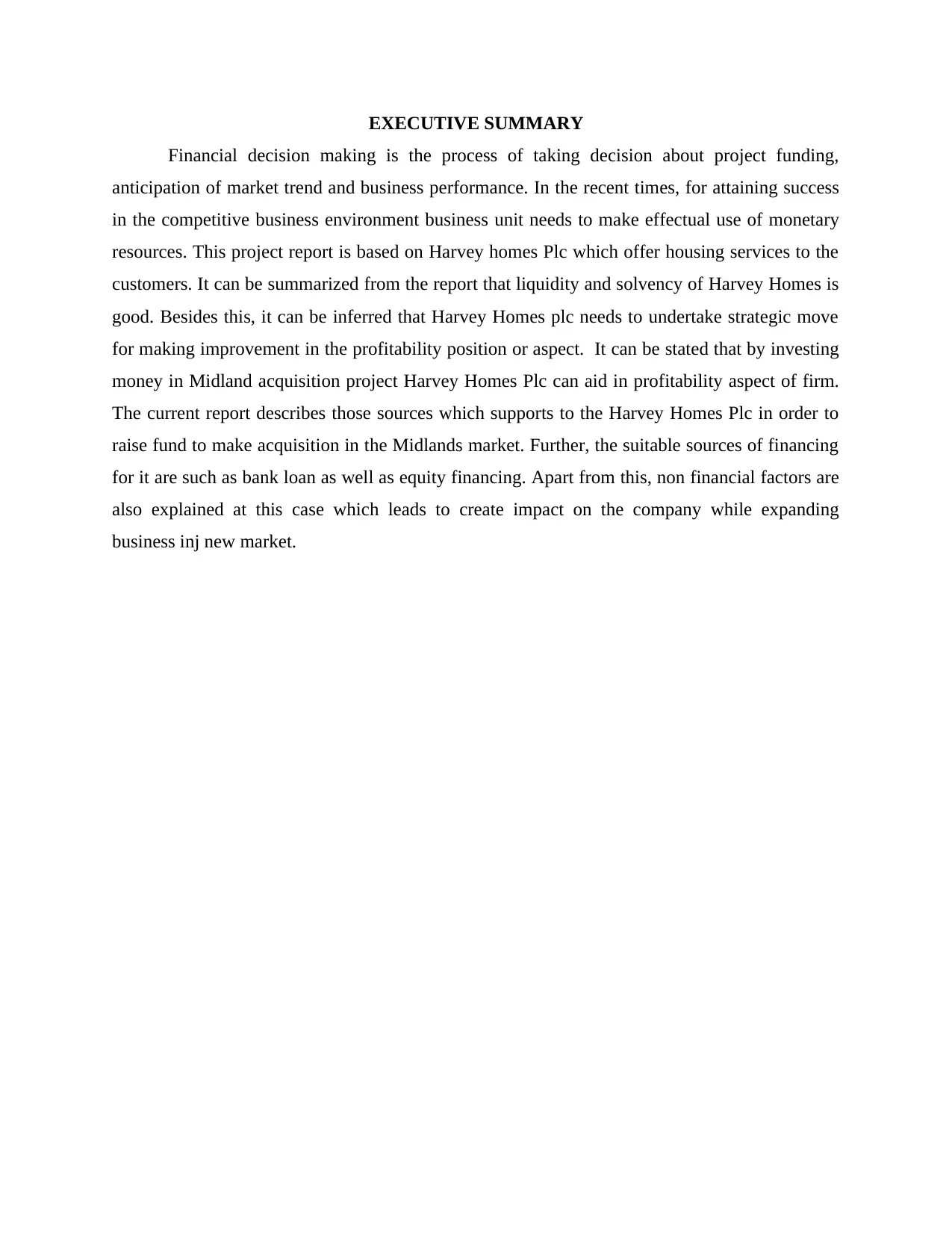
EXECUTIVE SUMMARY
Financial decision making is the process of taking decision about project funding,
anticipation of market trend and business performance. In the recent times, for attaining success
in the competitive business environment business unit needs to make effectual use of monetary
resources. This project report is based on Harvey homes Plc which offer housing services to the
customers. It can be summarized from the report that liquidity and solvency of Harvey Homes is
good. Besides this, it can be inferred that Harvey Homes plc needs to undertake strategic move
for making improvement in the profitability position or aspect. It can be stated that by investing
money in Midland acquisition project Harvey Homes Plc can aid in profitability aspect of firm.
The current report describes those sources which supports to the Harvey Homes Plc in order to
raise fund to make acquisition in the Midlands market. Further, the suitable sources of financing
for it are such as bank loan as well as equity financing. Apart from this, non financial factors are
also explained at this case which leads to create impact on the company while expanding
business inj new market.
Financial decision making is the process of taking decision about project funding,
anticipation of market trend and business performance. In the recent times, for attaining success
in the competitive business environment business unit needs to make effectual use of monetary
resources. This project report is based on Harvey homes Plc which offer housing services to the
customers. It can be summarized from the report that liquidity and solvency of Harvey Homes is
good. Besides this, it can be inferred that Harvey Homes plc needs to undertake strategic move
for making improvement in the profitability position or aspect. It can be stated that by investing
money in Midland acquisition project Harvey Homes Plc can aid in profitability aspect of firm.
The current report describes those sources which supports to the Harvey Homes Plc in order to
raise fund to make acquisition in the Midlands market. Further, the suitable sources of financing
for it are such as bank loan as well as equity financing. Apart from this, non financial factors are
also explained at this case which leads to create impact on the company while expanding
business inj new market.
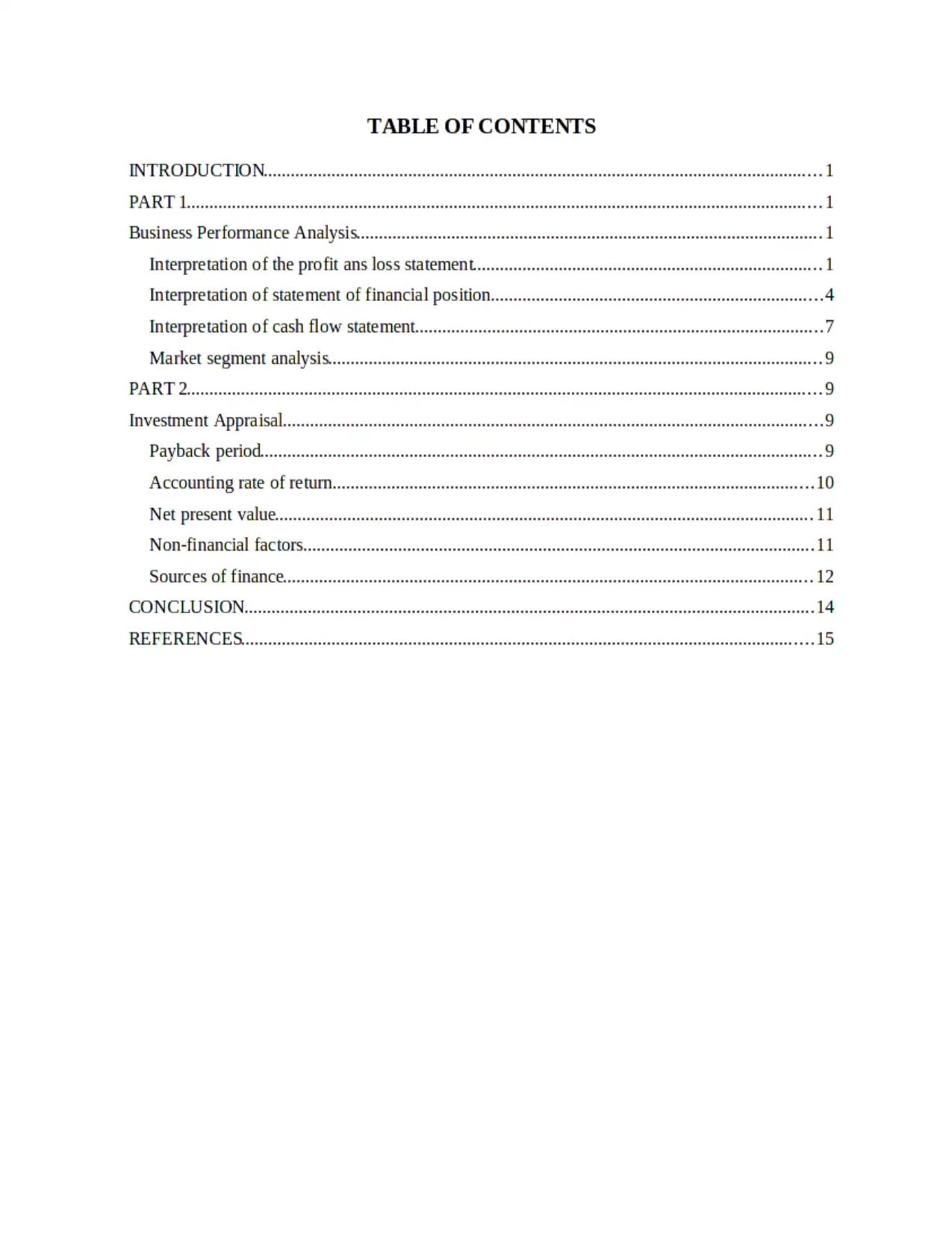
⊘ This is a preview!⊘
Do you want full access?
Subscribe today to unlock all pages.

Trusted by 1+ million students worldwide
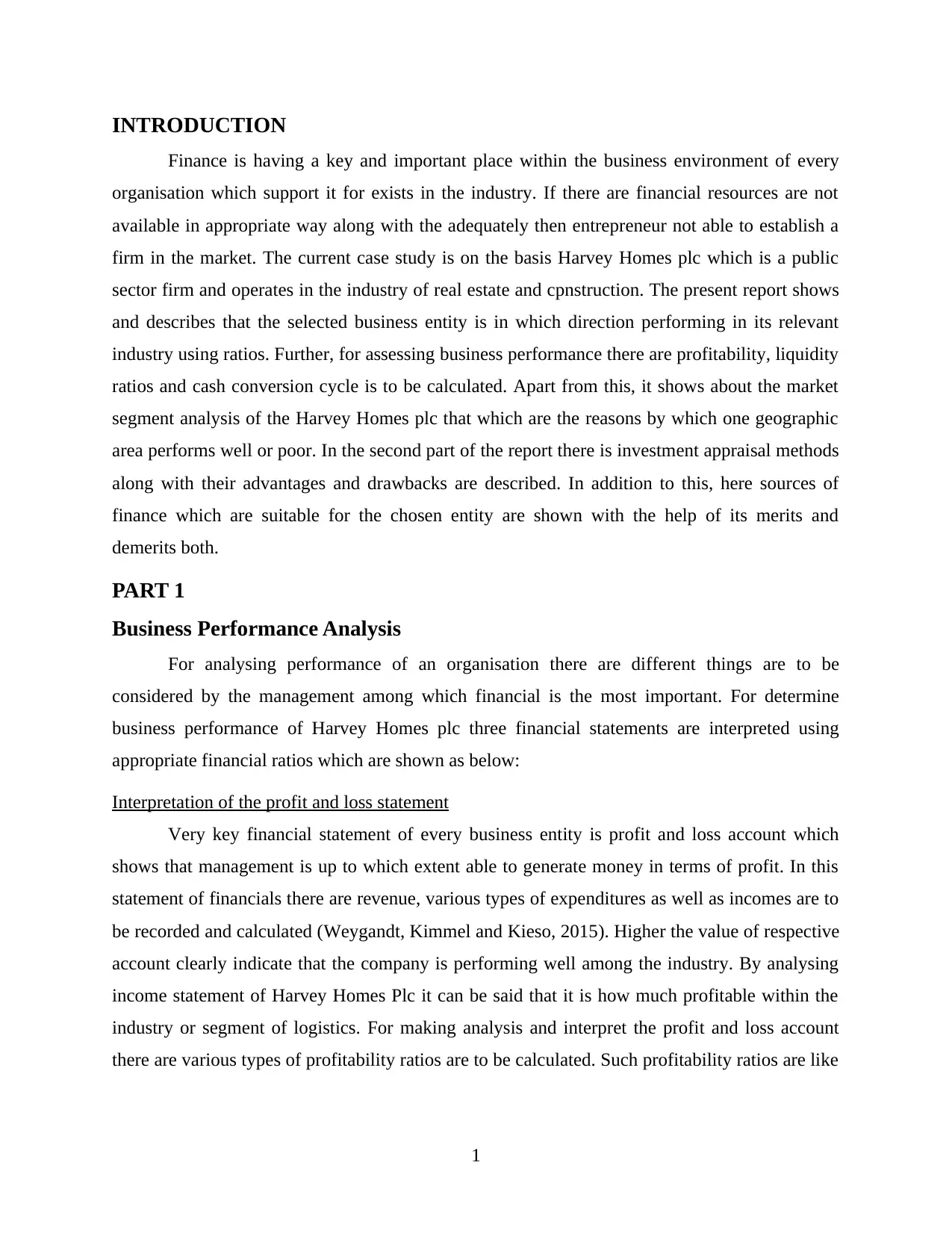
INTRODUCTION
Finance is having a key and important place within the business environment of every
organisation which support it for exists in the industry. If there are financial resources are not
available in appropriate way along with the adequately then entrepreneur not able to establish a
firm in the market. The current case study is on the basis Harvey Homes plc which is a public
sector firm and operates in the industry of real estate and cpnstruction. The present report shows
and describes that the selected business entity is in which direction performing in its relevant
industry using ratios. Further, for assessing business performance there are profitability, liquidity
ratios and cash conversion cycle is to be calculated. Apart from this, it shows about the market
segment analysis of the Harvey Homes plc that which are the reasons by which one geographic
area performs well or poor. In the second part of the report there is investment appraisal methods
along with their advantages and drawbacks are described. In addition to this, here sources of
finance which are suitable for the chosen entity are shown with the help of its merits and
demerits both.
PART 1
Business Performance Analysis
For analysing performance of an organisation there are different things are to be
considered by the management among which financial is the most important. For determine
business performance of Harvey Homes plc three financial statements are interpreted using
appropriate financial ratios which are shown as below:
Interpretation of the profit and loss statement
Very key financial statement of every business entity is profit and loss account which
shows that management is up to which extent able to generate money in terms of profit. In this
statement of financials there are revenue, various types of expenditures as well as incomes are to
be recorded and calculated (Weygandt, Kimmel and Kieso, 2015). Higher the value of respective
account clearly indicate that the company is performing well among the industry. By analysing
income statement of Harvey Homes Plc it can be said that it is how much profitable within the
industry or segment of logistics. For making analysis and interpret the profit and loss account
there are various types of profitability ratios are to be calculated. Such profitability ratios are like
1
Finance is having a key and important place within the business environment of every
organisation which support it for exists in the industry. If there are financial resources are not
available in appropriate way along with the adequately then entrepreneur not able to establish a
firm in the market. The current case study is on the basis Harvey Homes plc which is a public
sector firm and operates in the industry of real estate and cpnstruction. The present report shows
and describes that the selected business entity is in which direction performing in its relevant
industry using ratios. Further, for assessing business performance there are profitability, liquidity
ratios and cash conversion cycle is to be calculated. Apart from this, it shows about the market
segment analysis of the Harvey Homes plc that which are the reasons by which one geographic
area performs well or poor. In the second part of the report there is investment appraisal methods
along with their advantages and drawbacks are described. In addition to this, here sources of
finance which are suitable for the chosen entity are shown with the help of its merits and
demerits both.
PART 1
Business Performance Analysis
For analysing performance of an organisation there are different things are to be
considered by the management among which financial is the most important. For determine
business performance of Harvey Homes plc three financial statements are interpreted using
appropriate financial ratios which are shown as below:
Interpretation of the profit and loss statement
Very key financial statement of every business entity is profit and loss account which
shows that management is up to which extent able to generate money in terms of profit. In this
statement of financials there are revenue, various types of expenditures as well as incomes are to
be recorded and calculated (Weygandt, Kimmel and Kieso, 2015). Higher the value of respective
account clearly indicate that the company is performing well among the industry. By analysing
income statement of Harvey Homes Plc it can be said that it is how much profitable within the
industry or segment of logistics. For making analysis and interpret the profit and loss account
there are various types of profitability ratios are to be calculated. Such profitability ratios are like
1
Paraphrase This Document
Need a fresh take? Get an instant paraphrase of this document with our AI Paraphraser
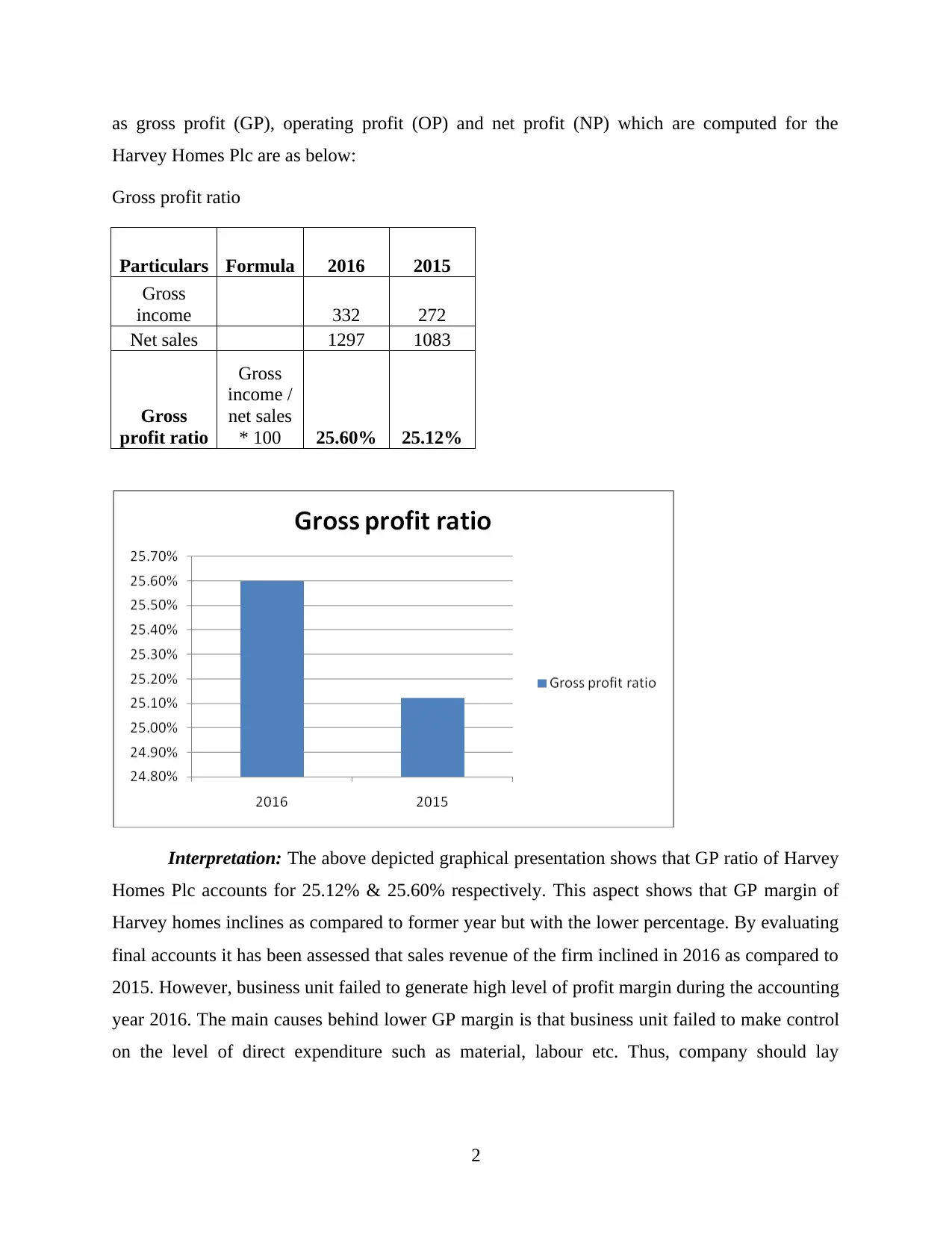
as gross profit (GP), operating profit (OP) and net profit (NP) which are computed for the
Harvey Homes Plc are as below:
Gross profit ratio
Particulars Formula 2016 2015
Gross
income 332 272
Net sales 1297 1083
Gross
profit ratio
Gross
income /
net sales
* 100 25.60% 25.12%
Interpretation: The above depicted graphical presentation shows that GP ratio of Harvey
Homes Plc accounts for 25.12% & 25.60% respectively. This aspect shows that GP margin of
Harvey homes inclines as compared to former year but with the lower percentage. By evaluating
final accounts it has been assessed that sales revenue of the firm inclined in 2016 as compared to
2015. However, business unit failed to generate high level of profit margin during the accounting
year 2016. The main causes behind lower GP margin is that business unit failed to make control
on the level of direct expenditure such as material, labour etc. Thus, company should lay
2
Harvey Homes Plc are as below:
Gross profit ratio
Particulars Formula 2016 2015
Gross
income 332 272
Net sales 1297 1083
Gross
profit ratio
Gross
income /
net sales
* 100 25.60% 25.12%
Interpretation: The above depicted graphical presentation shows that GP ratio of Harvey
Homes Plc accounts for 25.12% & 25.60% respectively. This aspect shows that GP margin of
Harvey homes inclines as compared to former year but with the lower percentage. By evaluating
final accounts it has been assessed that sales revenue of the firm inclined in 2016 as compared to
2015. However, business unit failed to generate high level of profit margin during the accounting
year 2016. The main causes behind lower GP margin is that business unit failed to make control
on the level of direct expenditure such as material, labour etc. Thus, company should lay
2
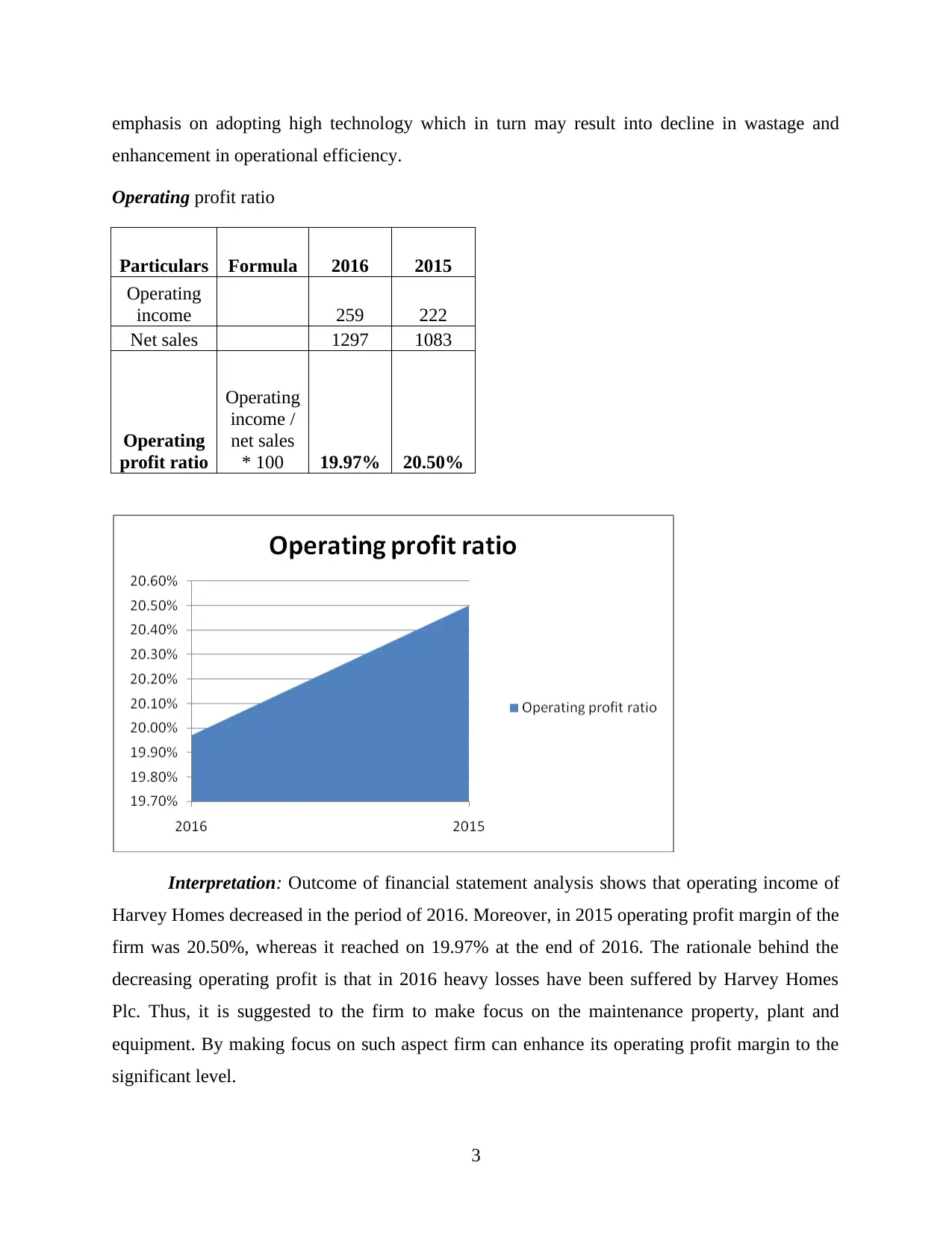
emphasis on adopting high technology which in turn may result into decline in wastage and
enhancement in operational efficiency.
Operating profit ratio
Particulars Formula 2016 2015
Operating
income 259 222
Net sales 1297 1083
Operating
profit ratio
Operating
income /
net sales
* 100 19.97% 20.50%
Interpretation: Outcome of financial statement analysis shows that operating income of
Harvey Homes decreased in the period of 2016. Moreover, in 2015 operating profit margin of the
firm was 20.50%, whereas it reached on 19.97% at the end of 2016. The rationale behind the
decreasing operating profit is that in 2016 heavy losses have been suffered by Harvey Homes
Plc. Thus, it is suggested to the firm to make focus on the maintenance property, plant and
equipment. By making focus on such aspect firm can enhance its operating profit margin to the
significant level.
3
enhancement in operational efficiency.
Operating profit ratio
Particulars Formula 2016 2015
Operating
income 259 222
Net sales 1297 1083
Operating
profit ratio
Operating
income /
net sales
* 100 19.97% 20.50%
Interpretation: Outcome of financial statement analysis shows that operating income of
Harvey Homes decreased in the period of 2016. Moreover, in 2015 operating profit margin of the
firm was 20.50%, whereas it reached on 19.97% at the end of 2016. The rationale behind the
decreasing operating profit is that in 2016 heavy losses have been suffered by Harvey Homes
Plc. Thus, it is suggested to the firm to make focus on the maintenance property, plant and
equipment. By making focus on such aspect firm can enhance its operating profit margin to the
significant level.
3
⊘ This is a preview!⊘
Do you want full access?
Subscribe today to unlock all pages.

Trusted by 1+ million students worldwide
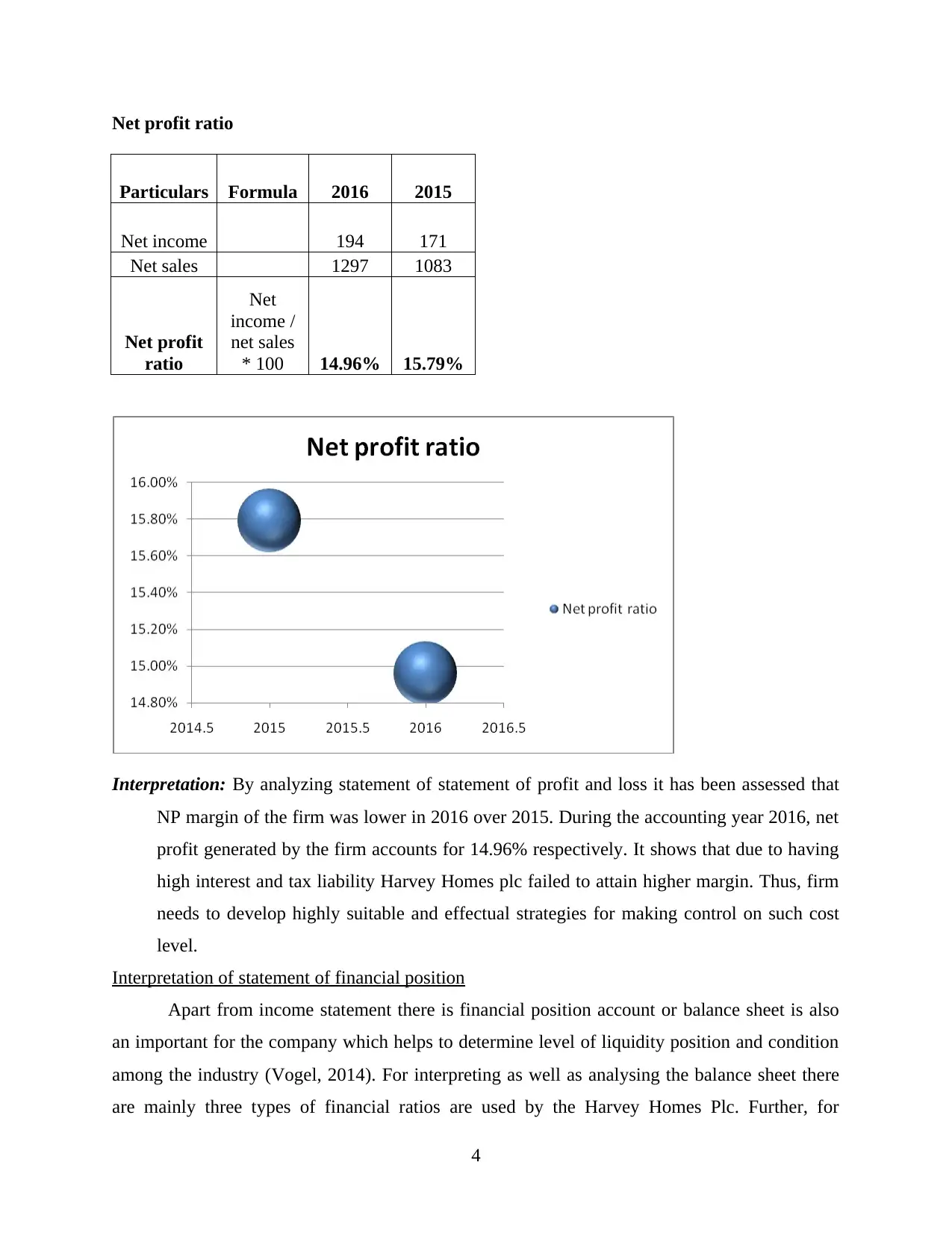
Net profit ratio
Particulars Formula 2016 2015
Net income 194 171
Net sales 1297 1083
Net profit
ratio
Net
income /
net sales
* 100 14.96% 15.79%
Interpretation: By analyzing statement of statement of profit and loss it has been assessed that
NP margin of the firm was lower in 2016 over 2015. During the accounting year 2016, net
profit generated by the firm accounts for 14.96% respectively. It shows that due to having
high interest and tax liability Harvey Homes plc failed to attain higher margin. Thus, firm
needs to develop highly suitable and effectual strategies for making control on such cost
level.
Interpretation of statement of financial position
Apart from income statement there is financial position account or balance sheet is also
an important for the company which helps to determine level of liquidity position and condition
among the industry (Vogel, 2014). For interpreting as well as analysing the balance sheet there
are mainly three types of financial ratios are used by the Harvey Homes Plc. Further, for
4
Particulars Formula 2016 2015
Net income 194 171
Net sales 1297 1083
Net profit
ratio
Net
income /
net sales
* 100 14.96% 15.79%
Interpretation: By analyzing statement of statement of profit and loss it has been assessed that
NP margin of the firm was lower in 2016 over 2015. During the accounting year 2016, net
profit generated by the firm accounts for 14.96% respectively. It shows that due to having
high interest and tax liability Harvey Homes plc failed to attain higher margin. Thus, firm
needs to develop highly suitable and effectual strategies for making control on such cost
level.
Interpretation of statement of financial position
Apart from income statement there is financial position account or balance sheet is also
an important for the company which helps to determine level of liquidity position and condition
among the industry (Vogel, 2014). For interpreting as well as analysing the balance sheet there
are mainly three types of financial ratios are used by the Harvey Homes Plc. Further, for
4
Paraphrase This Document
Need a fresh take? Get an instant paraphrase of this document with our AI Paraphraser
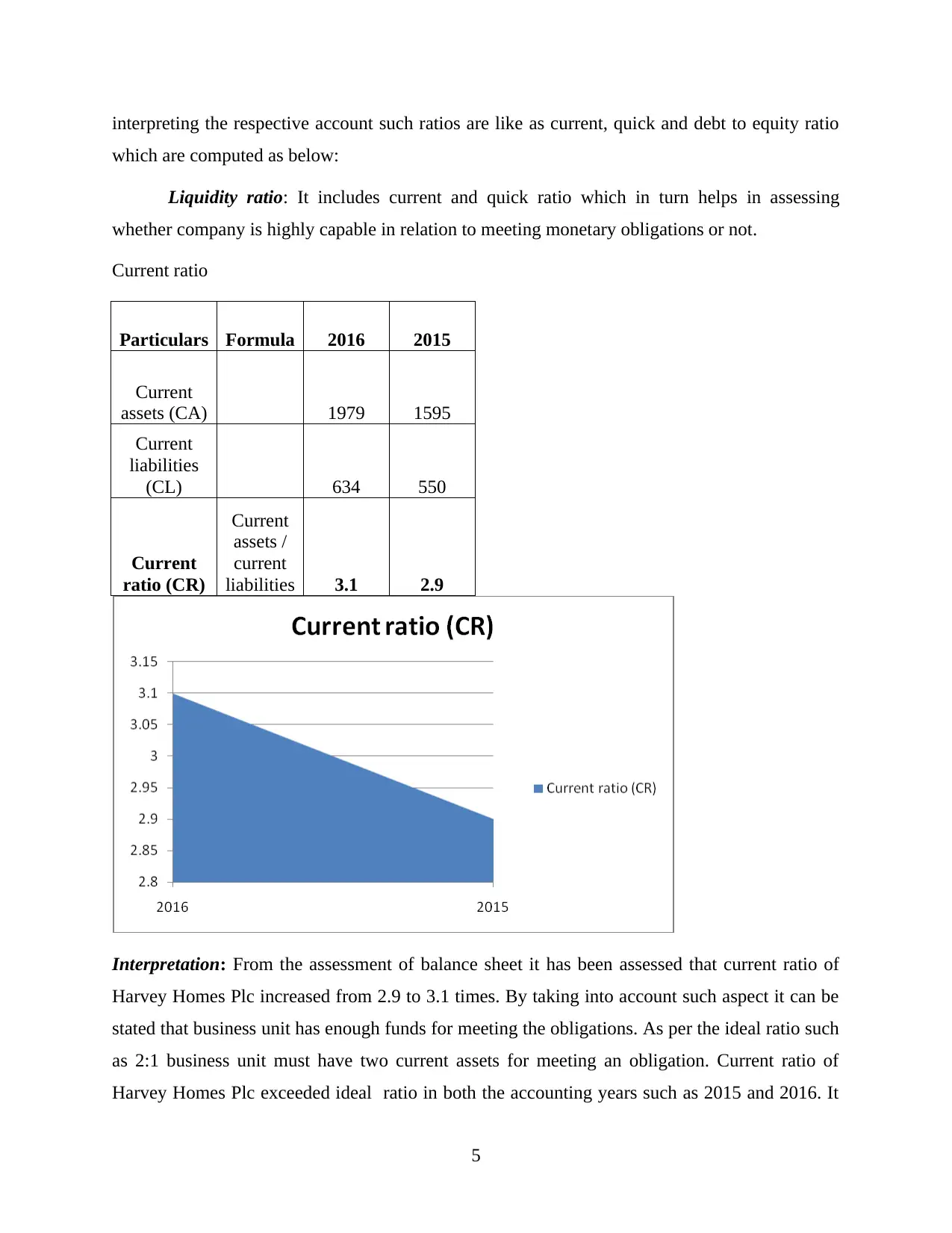
interpreting the respective account such ratios are like as current, quick and debt to equity ratio
which are computed as below:
Liquidity ratio: It includes current and quick ratio which in turn helps in assessing
whether company is highly capable in relation to meeting monetary obligations or not.
Current ratio
Particulars Formula 2016 2015
Current
assets (CA) 1979 1595
Current
liabilities
(CL) 634 550
Current
ratio (CR)
Current
assets /
current
liabilities 3.1 2.9
Interpretation: From the assessment of balance sheet it has been assessed that current ratio of
Harvey Homes Plc increased from 2.9 to 3.1 times. By taking into account such aspect it can be
stated that business unit has enough funds for meeting the obligations. As per the ideal ratio such
as 2:1 business unit must have two current assets for meeting an obligation. Current ratio of
Harvey Homes Plc exceeded ideal ratio in both the accounting years such as 2015 and 2016. It
5
which are computed as below:
Liquidity ratio: It includes current and quick ratio which in turn helps in assessing
whether company is highly capable in relation to meeting monetary obligations or not.
Current ratio
Particulars Formula 2016 2015
Current
assets (CA) 1979 1595
Current
liabilities
(CL) 634 550
Current
ratio (CR)
Current
assets /
current
liabilities 3.1 2.9
Interpretation: From the assessment of balance sheet it has been assessed that current ratio of
Harvey Homes Plc increased from 2.9 to 3.1 times. By taking into account such aspect it can be
stated that business unit has enough funds for meeting the obligations. As per the ideal ratio such
as 2:1 business unit must have two current assets for meeting an obligation. Current ratio of
Harvey Homes Plc exceeded ideal ratio in both the accounting years such as 2015 and 2016. It
5
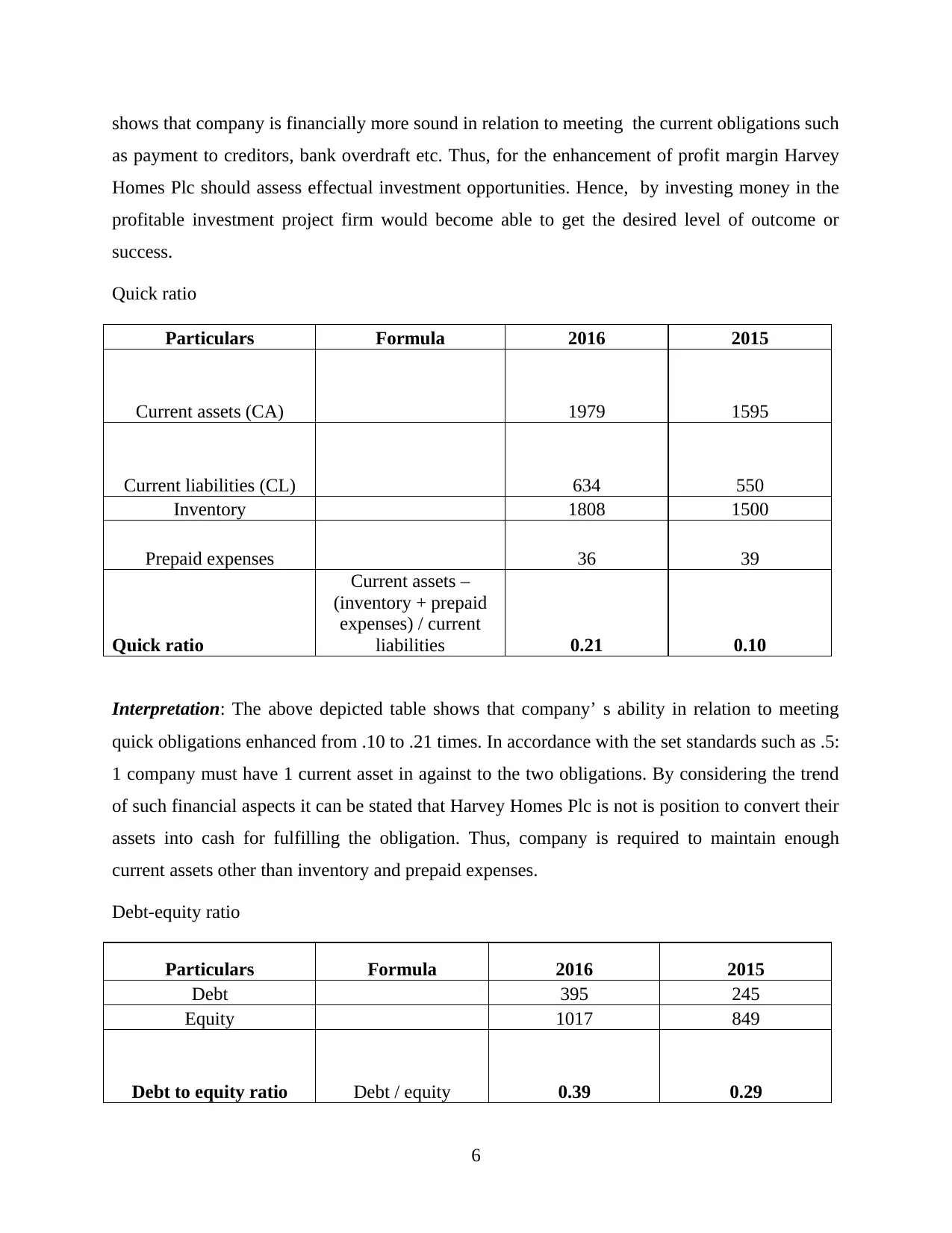
shows that company is financially more sound in relation to meeting the current obligations such
as payment to creditors, bank overdraft etc. Thus, for the enhancement of profit margin Harvey
Homes Plc should assess effectual investment opportunities. Hence, by investing money in the
profitable investment project firm would become able to get the desired level of outcome or
success.
Quick ratio
Particulars Formula 2016 2015
Current assets (CA) 1979 1595
Current liabilities (CL) 634 550
Inventory 1808 1500
Prepaid expenses 36 39
Quick ratio
Current assets –
(inventory + prepaid
expenses) / current
liabilities 0.21 0.10
Interpretation: The above depicted table shows that company’ s ability in relation to meeting
quick obligations enhanced from .10 to .21 times. In accordance with the set standards such as .5:
1 company must have 1 current asset in against to the two obligations. By considering the trend
of such financial aspects it can be stated that Harvey Homes Plc is not is position to convert their
assets into cash for fulfilling the obligation. Thus, company is required to maintain enough
current assets other than inventory and prepaid expenses.
Debt-equity ratio
Particulars Formula 2016 2015
Debt 395 245
Equity 1017 849
Debt to equity ratio Debt / equity 0.39 0.29
6
as payment to creditors, bank overdraft etc. Thus, for the enhancement of profit margin Harvey
Homes Plc should assess effectual investment opportunities. Hence, by investing money in the
profitable investment project firm would become able to get the desired level of outcome or
success.
Quick ratio
Particulars Formula 2016 2015
Current assets (CA) 1979 1595
Current liabilities (CL) 634 550
Inventory 1808 1500
Prepaid expenses 36 39
Quick ratio
Current assets –
(inventory + prepaid
expenses) / current
liabilities 0.21 0.10
Interpretation: The above depicted table shows that company’ s ability in relation to meeting
quick obligations enhanced from .10 to .21 times. In accordance with the set standards such as .5:
1 company must have 1 current asset in against to the two obligations. By considering the trend
of such financial aspects it can be stated that Harvey Homes Plc is not is position to convert their
assets into cash for fulfilling the obligation. Thus, company is required to maintain enough
current assets other than inventory and prepaid expenses.
Debt-equity ratio
Particulars Formula 2016 2015
Debt 395 245
Equity 1017 849
Debt to equity ratio Debt / equity 0.39 0.29
6
⊘ This is a preview!⊘
Do you want full access?
Subscribe today to unlock all pages.

Trusted by 1+ million students worldwide
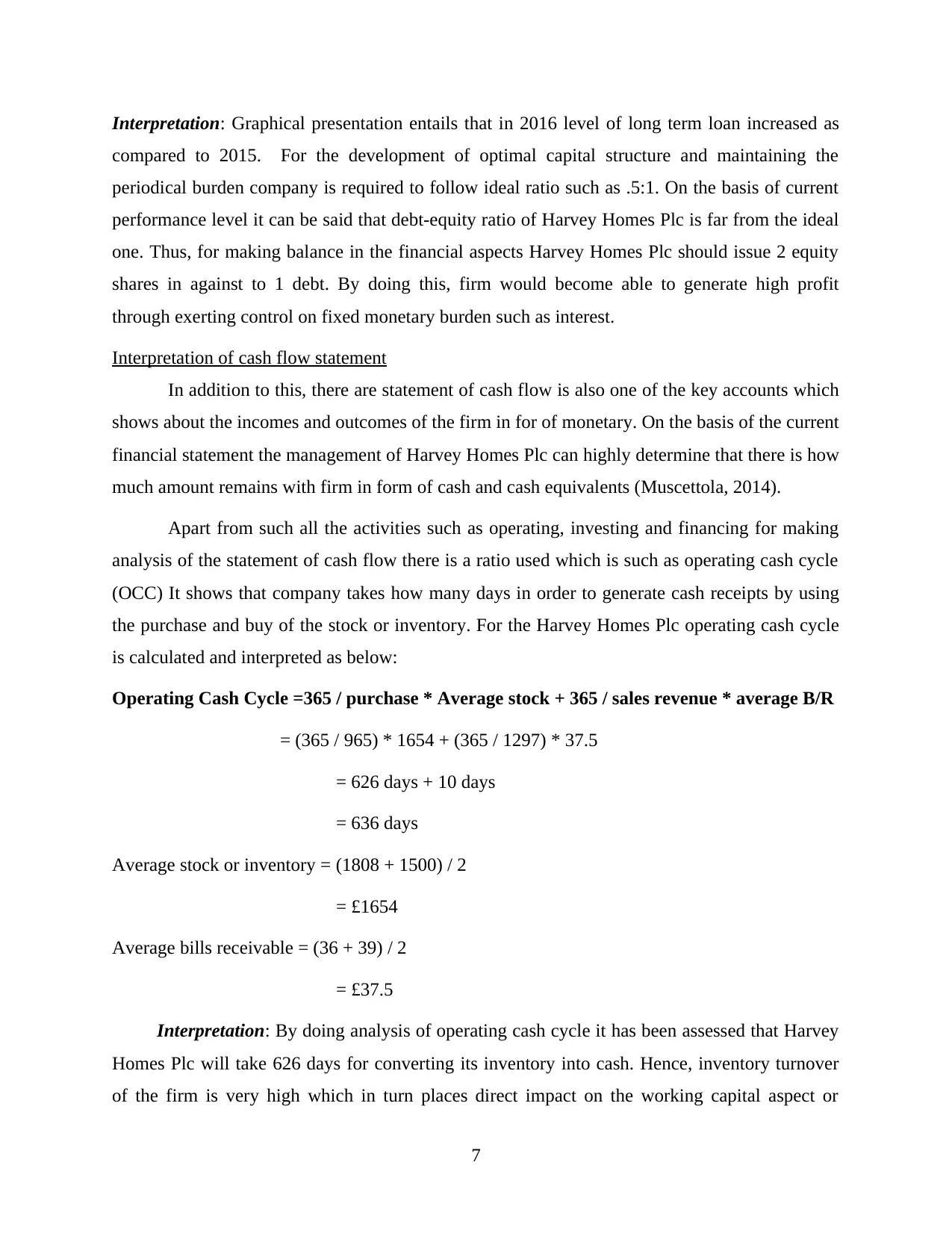
Interpretation: Graphical presentation entails that in 2016 level of long term loan increased as
compared to 2015. For the development of optimal capital structure and maintaining the
periodical burden company is required to follow ideal ratio such as .5:1. On the basis of current
performance level it can be said that debt-equity ratio of Harvey Homes Plc is far from the ideal
one. Thus, for making balance in the financial aspects Harvey Homes Plc should issue 2 equity
shares in against to 1 debt. By doing this, firm would become able to generate high profit
through exerting control on fixed monetary burden such as interest.
Interpretation of cash flow statement
In addition to this, there are statement of cash flow is also one of the key accounts which
shows about the incomes and outcomes of the firm in for of monetary. On the basis of the current
financial statement the management of Harvey Homes Plc can highly determine that there is how
much amount remains with firm in form of cash and cash equivalents (Muscettola, 2014).
Apart from such all the activities such as operating, investing and financing for making
analysis of the statement of cash flow there is a ratio used which is such as operating cash cycle
(OCC) It shows that company takes how many days in order to generate cash receipts by using
the purchase and buy of the stock or inventory. For the Harvey Homes Plc operating cash cycle
is calculated and interpreted as below:
Operating Cash Cycle =365 / purchase * Average stock + 365 / sales revenue * average B/R
= (365 / 965) * 1654 + (365 / 1297) * 37.5
= 626 days + 10 days
= 636 days
Average stock or inventory = (1808 + 1500) / 2
= £1654
Average bills receivable = (36 + 39) / 2
= £37.5
Interpretation: By doing analysis of operating cash cycle it has been assessed that Harvey
Homes Plc will take 626 days for converting its inventory into cash. Hence, inventory turnover
of the firm is very high which in turn places direct impact on the working capital aspect or
7
compared to 2015. For the development of optimal capital structure and maintaining the
periodical burden company is required to follow ideal ratio such as .5:1. On the basis of current
performance level it can be said that debt-equity ratio of Harvey Homes Plc is far from the ideal
one. Thus, for making balance in the financial aspects Harvey Homes Plc should issue 2 equity
shares in against to 1 debt. By doing this, firm would become able to generate high profit
through exerting control on fixed monetary burden such as interest.
Interpretation of cash flow statement
In addition to this, there are statement of cash flow is also one of the key accounts which
shows about the incomes and outcomes of the firm in for of monetary. On the basis of the current
financial statement the management of Harvey Homes Plc can highly determine that there is how
much amount remains with firm in form of cash and cash equivalents (Muscettola, 2014).
Apart from such all the activities such as operating, investing and financing for making
analysis of the statement of cash flow there is a ratio used which is such as operating cash cycle
(OCC) It shows that company takes how many days in order to generate cash receipts by using
the purchase and buy of the stock or inventory. For the Harvey Homes Plc operating cash cycle
is calculated and interpreted as below:
Operating Cash Cycle =365 / purchase * Average stock + 365 / sales revenue * average B/R
= (365 / 965) * 1654 + (365 / 1297) * 37.5
= 626 days + 10 days
= 636 days
Average stock or inventory = (1808 + 1500) / 2
= £1654
Average bills receivable = (36 + 39) / 2
= £37.5
Interpretation: By doing analysis of operating cash cycle it has been assessed that Harvey
Homes Plc will take 626 days for converting its inventory into cash. Hence, inventory turnover
of the firm is very high which in turn places direct impact on the working capital aspect or
7
Paraphrase This Document
Need a fresh take? Get an instant paraphrase of this document with our AI Paraphraser
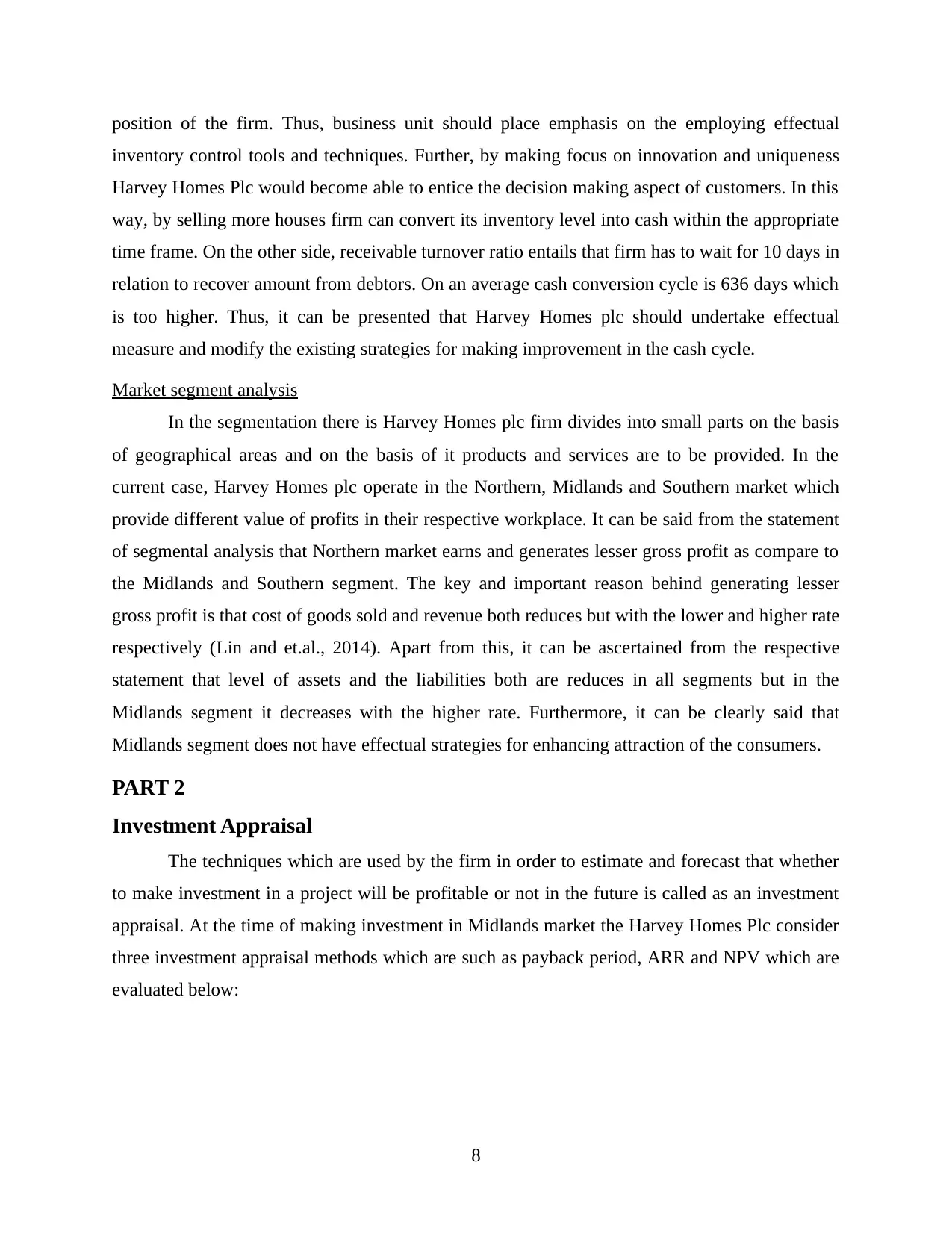
position of the firm. Thus, business unit should place emphasis on the employing effectual
inventory control tools and techniques. Further, by making focus on innovation and uniqueness
Harvey Homes Plc would become able to entice the decision making aspect of customers. In this
way, by selling more houses firm can convert its inventory level into cash within the appropriate
time frame. On the other side, receivable turnover ratio entails that firm has to wait for 10 days in
relation to recover amount from debtors. On an average cash conversion cycle is 636 days which
is too higher. Thus, it can be presented that Harvey Homes plc should undertake effectual
measure and modify the existing strategies for making improvement in the cash cycle.
Market segment analysis
In the segmentation there is Harvey Homes plc firm divides into small parts on the basis
of geographical areas and on the basis of it products and services are to be provided. In the
current case, Harvey Homes plc operate in the Northern, Midlands and Southern market which
provide different value of profits in their respective workplace. It can be said from the statement
of segmental analysis that Northern market earns and generates lesser gross profit as compare to
the Midlands and Southern segment. The key and important reason behind generating lesser
gross profit is that cost of goods sold and revenue both reduces but with the lower and higher rate
respectively (Lin and et.al., 2014). Apart from this, it can be ascertained from the respective
statement that level of assets and the liabilities both are reduces in all segments but in the
Midlands segment it decreases with the higher rate. Furthermore, it can be clearly said that
Midlands segment does not have effectual strategies for enhancing attraction of the consumers.
PART 2
Investment Appraisal
The techniques which are used by the firm in order to estimate and forecast that whether
to make investment in a project will be profitable or not in the future is called as an investment
appraisal. At the time of making investment in Midlands market the Harvey Homes Plc consider
three investment appraisal methods which are such as payback period, ARR and NPV which are
evaluated below:
8
inventory control tools and techniques. Further, by making focus on innovation and uniqueness
Harvey Homes Plc would become able to entice the decision making aspect of customers. In this
way, by selling more houses firm can convert its inventory level into cash within the appropriate
time frame. On the other side, receivable turnover ratio entails that firm has to wait for 10 days in
relation to recover amount from debtors. On an average cash conversion cycle is 636 days which
is too higher. Thus, it can be presented that Harvey Homes plc should undertake effectual
measure and modify the existing strategies for making improvement in the cash cycle.
Market segment analysis
In the segmentation there is Harvey Homes plc firm divides into small parts on the basis
of geographical areas and on the basis of it products and services are to be provided. In the
current case, Harvey Homes plc operate in the Northern, Midlands and Southern market which
provide different value of profits in their respective workplace. It can be said from the statement
of segmental analysis that Northern market earns and generates lesser gross profit as compare to
the Midlands and Southern segment. The key and important reason behind generating lesser
gross profit is that cost of goods sold and revenue both reduces but with the lower and higher rate
respectively (Lin and et.al., 2014). Apart from this, it can be ascertained from the respective
statement that level of assets and the liabilities both are reduces in all segments but in the
Midlands segment it decreases with the higher rate. Furthermore, it can be clearly said that
Midlands segment does not have effectual strategies for enhancing attraction of the consumers.
PART 2
Investment Appraisal
The techniques which are used by the firm in order to estimate and forecast that whether
to make investment in a project will be profitable or not in the future is called as an investment
appraisal. At the time of making investment in Midlands market the Harvey Homes Plc consider
three investment appraisal methods which are such as payback period, ARR and NPV which are
evaluated below:
8
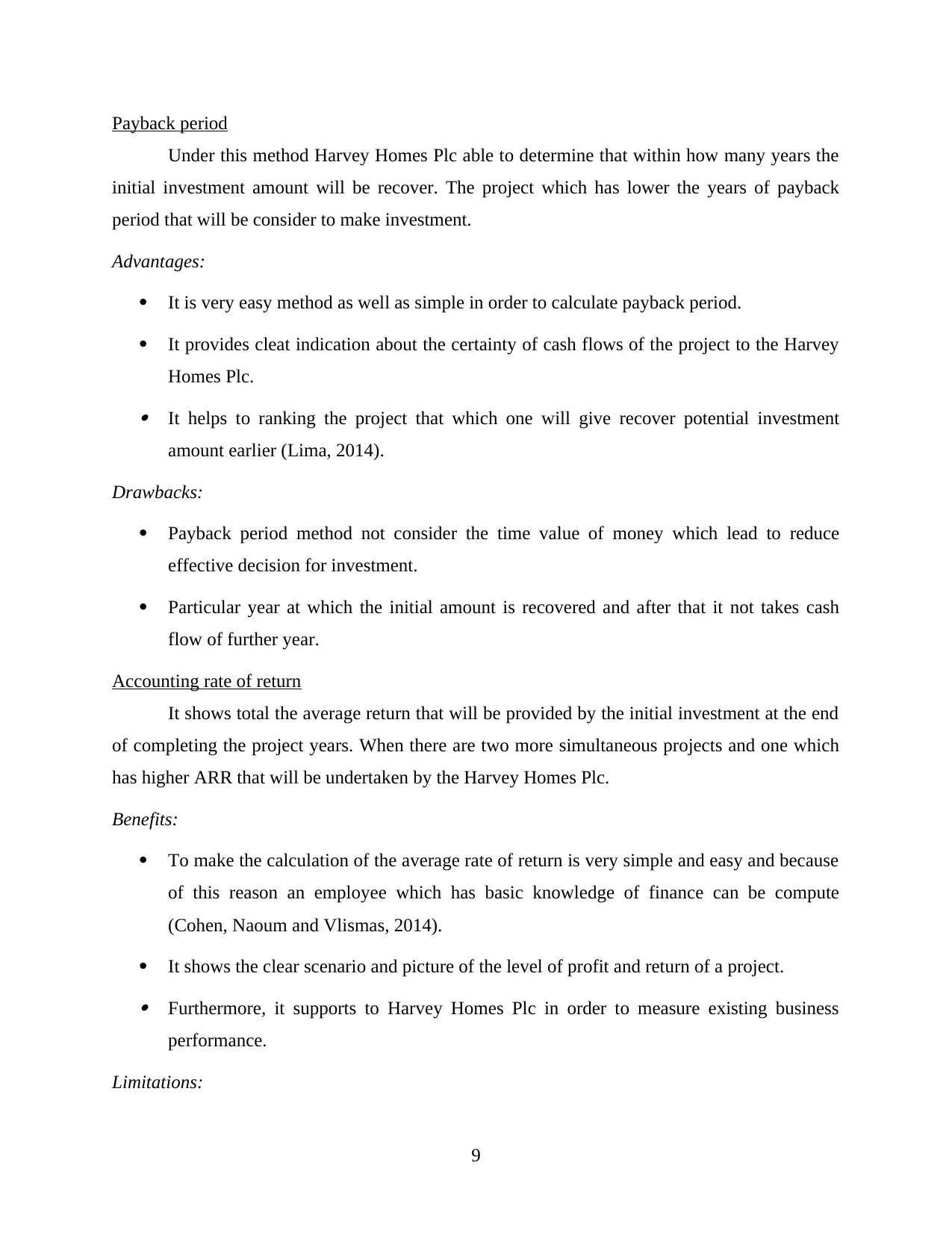
Payback period
Under this method Harvey Homes Plc able to determine that within how many years the
initial investment amount will be recover. The project which has lower the years of payback
period that will be consider to make investment.
Advantages:
It is very easy method as well as simple in order to calculate payback period.
It provides cleat indication about the certainty of cash flows of the project to the Harvey
Homes Plc. It helps to ranking the project that which one will give recover potential investment
amount earlier (Lima, 2014).
Drawbacks:
Payback period method not consider the time value of money which lead to reduce
effective decision for investment.
Particular year at which the initial amount is recovered and after that it not takes cash
flow of further year.
Accounting rate of return
It shows total the average return that will be provided by the initial investment at the end
of completing the project years. When there are two more simultaneous projects and one which
has higher ARR that will be undertaken by the Harvey Homes Plc.
Benefits:
To make the calculation of the average rate of return is very simple and easy and because
of this reason an employee which has basic knowledge of finance can be compute
(Cohen, Naoum and Vlismas, 2014).
It shows the clear scenario and picture of the level of profit and return of a project. Furthermore, it supports to Harvey Homes Plc in order to measure existing business
performance.
Limitations:
9
Under this method Harvey Homes Plc able to determine that within how many years the
initial investment amount will be recover. The project which has lower the years of payback
period that will be consider to make investment.
Advantages:
It is very easy method as well as simple in order to calculate payback period.
It provides cleat indication about the certainty of cash flows of the project to the Harvey
Homes Plc. It helps to ranking the project that which one will give recover potential investment
amount earlier (Lima, 2014).
Drawbacks:
Payback period method not consider the time value of money which lead to reduce
effective decision for investment.
Particular year at which the initial amount is recovered and after that it not takes cash
flow of further year.
Accounting rate of return
It shows total the average return that will be provided by the initial investment at the end
of completing the project years. When there are two more simultaneous projects and one which
has higher ARR that will be undertaken by the Harvey Homes Plc.
Benefits:
To make the calculation of the average rate of return is very simple and easy and because
of this reason an employee which has basic knowledge of finance can be compute
(Cohen, Naoum and Vlismas, 2014).
It shows the clear scenario and picture of the level of profit and return of a project. Furthermore, it supports to Harvey Homes Plc in order to measure existing business
performance.
Limitations:
9
⊘ This is a preview!⊘
Do you want full access?
Subscribe today to unlock all pages.

Trusted by 1+ million students worldwide
1 out of 19
Related Documents
Your All-in-One AI-Powered Toolkit for Academic Success.
+13062052269
info@desklib.com
Available 24*7 on WhatsApp / Email
![[object Object]](/_next/static/media/star-bottom.7253800d.svg)
Unlock your academic potential
Copyright © 2020–2025 A2Z Services. All Rights Reserved. Developed and managed by ZUCOL.





